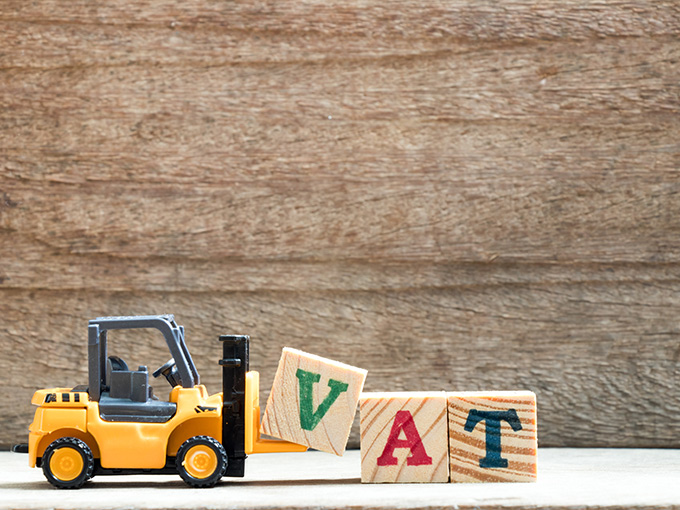This month, we highlight and comment on:
- EORI numbers – what they are needed for and who needs them,
- The VAT implications of Amazon’s Pan-EU fulfilment model for e-commerce merchants, and
- Spotlight on HMRC’s Help with VAT Compliance Controls guidelines with respect to purchases and VAT recovery.
In January, HMRC released a new landing page for its guidance on Economic Operator Registration and Identification (EORI) numbers. Whilst the guidance itself is not new, it’s worth a recap on what EORI numbers are and who needs them.
EORI numbers are issued to economic operators (EO’s), whose business involves imports into and exports from, the UK. An EO must have an EORI number before it can import goods as the importer of record and/or export goods as the exporter of record. The EORI number identifies the EO throughout the customs process and the EO can be a sole proprietor, partnership, UK incorporated company, a registered charity and an overseas company which is importing or exporting. Private individuals bringing their own possessions to the UK or removing them from the UK, would not need an EORI number.
If the EO is VAT registered, the first nine numbers of their EORI number will match their VAT number, typically then followed by a 000 suffix. Whilst this can lead to confusion, it is an easy way to check if you have an EORI number by entering your VAT number in HMRC’s online EORI number checker prefixed with GB and with the 000 suffix.
For VAT groups each member of the VAT group is treated separately, so only the members who import or export goods will require an EORI number. Each member’s EORI number will have the group’s VAT number as the first nine numbers, and then a different suffix depending on the VAT group control number which HMRC has assigned to that member (eg 001, 002 etc). When a member leaves the VAT group, their EORI number will no longer be valid, and they would need to apply for a new one.
An EO does not need to be VAT registered to have an EORI number although an EO would be wise to take advice regarding their activities and as not being VAT registered would mean import VAT paid when shipping goods into the UK, would not be recoverable.
Pre-Brexit a GB prefixed EORI number issued by HMRC would have been recognised by EU Member States’ customs systems, preventing the need for multiple EORI numbers in the case of undertaking customs activities elsewhere in the EU. Post-Brexit that is not the case, and UK EO’s importing into or exporting from, the EU, would need to apply for an EU issued EORI number in a Member State.
Comments
EORI numbers are not new but there is often confusion of what they are and who needs them. They are often confused with VAT registration numbers, and it’s sometimes the case that businesses are not even aware they have one.
EO’s which have obtained an EORI before they were issued with a VAT number will not receive the appropriate supporting documentation for import VAT recovery (eg the C79 certificate) and will not be able to apply Postponed Import VAT Accounting (PIVA).As soon as the VAT number is issued the EO would need to apply for a new EORI which is linked to its VAT number and no-longer use the original EORI number it was issued by HMRC. This will ensure import VAT is recoverable, subject to conditions, with either the C79 or PIVA statement documents as the support for this recovery.
Applying for an EORI number is a relatively straightforward process and they are generally issued within 48 hours by HMRC. However, if you’re intending to import or export goods for the first time, it pays to be well prepared and ensure your EORI number is in place prior to goods being shipped. If there is no EORI available at the time the import or export declarations are needing to be prepared, this will lead to issues which are often difficult to resolve, not least goods stuck at customs and unable to be shipped. This can have significant commercial implications, and therefore be well prepared ensuring a valid EORI is in place, is vital.
For any assistance or additional guidance on EORI numbers, please contact Nick Hart, VAT Director.
For UK e-commerce businesses looking to expand into the wider European market, models such as Amazon’s Pan-European FBA model provides an opportunity to scale sales quickly and reach a greater population of consumers. Whilst VAT rules which apply to online marketplaces such as Amazon, require the marketplace to collect and remit VAT on sales made by merchants through their platform, the merchants themselves may find they have VAT obligations in multiple countries as a result of signing up to Pan-European FBA.
Under the model a UK e-commerce business needs to have inventory stored in at least two of five of Amazon’s EU fulfilment centres, from France, Germany, Italy, Spain or Poland. So, the immediate challenge is the bulk shipment to the EU which would likely mean an import into the EU from a non-EU country. The merchant would need to arrange the import and pay customs duties and import VAT. There are some immediate challenges with this:
- Non-EU established parties need to appoint an indirect customs representative to import the goods on their behalf – such representatives have joint liability for customs duty and the accuracy of the import declarations.
- VAT registration required in the countries of import.
- Ensuring correct supporting documentation to reclaim import VAT paid.
- Managing local VAT compliance.
Further, under the fulfilment model, Amazon can move inventory stored with them, to another EU based fulfilment centre. Amazon has numerous others including ones located in Belgium, Sweden, Ireland and Czech Republic. In this instance, the goods which are still owned by the merchant, are moved from one Member State to another, for a reason other than to fulfil an order – they are being moved by Amazon to ensure adequate stock in regional markets. This amounts to a movement of own goods within the EU, which is treated as a supply for VAT purposes by the merchant to themselves. As a result, the merchant will also have to register for VAT in the Member States where Amazon is moving stock to, to ensure no VAT costs arises. Additional compliance obligations arise in multiple EU jurisdictions.
Comments
Undoubtedly fulfilment models offered by platforms such as Amazon, present huge opportunities for e-commerce merchants with exposure to larger consumer markets the obvious one. But VAT obligations arising from signing-up to a platform fulfilment model should not be overlooked and should indeed be planned for. In the future the extension of the EU One-Stop Shop compliance mechanism to include movement of own goods VAT reporting will simplify compliance obligations and reduce the cost of compliance, but for the time being UK merchants would need to plan for multiple country VAT compliance from a cost, and compliance management perspective.
For further information on the VAT implications of trading in the EU in the e-commerce market, please contact Nick Hart, VAT Director.
Since HMRC published its Help for VAT compliance controls Guidelines for VAT Compliance in September 2024, we have in previous VAT Updates spotlighted employee expenses and manual adjustments as areas to be particular mindful of, and our webinar in November last year went into a little more detail regarding businesses approach to VAT compliance processes.
This month we spotlight another specific element of the guidance on VAT compliance controls, namely ‘Procure to Pay’ ie the accounts payable and input tax recovery process.
A lack of control and process around how a business orders and receives supplies of goods and services for its business, can result in significant issues with claiming back VAT. Common issues that arise, which either delay or prevent VAT recovery include:
- Lack of valid VAT invoice from supplier.
- VAT invoice not issued to/addressed to the correct party.
- Pro forma invoices, quotations, or order confirmations being incorrectly used to support VAT recovery.
- Foreign VAT paid being included as input tax on a UK VAT return.
- VAT incorrectly charged by the supplier, which is not recoverable.
- VAT being reclaimed on blocked costs such as the purchase of cars, and business entertainment.
- A party which has not received the supply in question (but it has been received by another party) trying to reclaim the VAT paid.
Businesses should ensure that controls and processes with respect to Procure to Pay matters are adequate to prevent these issues arising, or to ensure they are correctly dealt with before the VAT is reported as recoverable on the VAT returns. The guidance also describes control points for services purchased which are subject to reverse charge VAT.
For the accounts payable function, HMRC expect to see control points within the process, which include those around ensuring valid VAT invoices are held to support VAT recovery, and invoices coded or allocated correctly, in terms of whether the costs relate to taxable business activities or something else. HMRC would expect those employees booking purchase invoices to have appropriate VAT knowledge to allow them to correctly post invoices for VAT recovery purposes, and to identify any issues which would need actions to be taken before VAT is posted as recoverable.
Similarly suitable controls should be in place to identify services being received from overseas suppliers, with respect to which reverse charge VAT is due for the recipient, invoices received which are subject to the domestic reverse charge (eg invoices received for construction services), and to identify self-billed invoices being received which should be posted as sales invoices, not purchase invoices.
Comments
An old adage of VAT is right tax right time, and the ultimate aim of the Procure to Pay guidelines for VAT compliance is to give businesses the opportunity to implement expected processes and controls to enable the right amount of VAT to be reclaimed, at the right time. The right amount being what a business is entitled to reclaim given the nature of the cost on which VAT has been paid, what that cost is used for by the business, and the quality and completeness of the supporting documentation (typically a valid VAT invoice).
The approach to VAT recovery is a key element which HMRC will consider during any assurance event or inspection of the VAT records. A lack of control and review process around VAT recovery and how purchase invoices are being booked, will often result in VAT errors, which HMRC would assess for, with interest and penalties.
Saffery regularly advises clients on VAT compliance controls and processes, helping them to develop sufficiently robust systems designed to identify issues, and greatly reduce the risk of errors being made. Please get in touch with Nick Hart , VAT Director, to discuss further.
Contact us
Partner, Edinburgh
Key experience




